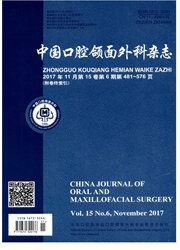

 中文摘要:
中文摘要:
目的:检测兔颞下颌关节(temporomandibular joint,TMJ)结构紊乱(internal derangement,ID)模型滑膜组织的显微及超微结构变化。方法:建立兔关节ID模型,术后1~4周进行内镜评价时,采集滑膜组织,制备光镜和电镜标本,观察其滑膜细胞的显微及超微结构变化;CD34计数小血管数目,比较实验侧和对照侧滑膜组织中的血管数目,采用SPSS16.0软件包进行配对t检验,比较各组之间滑膜组织中小血管数目有无差异。结果:建模术后1周,实验侧小血管数目平均为9.77±1.59,对照侧小血管数目平均为3.46±0.52,2组之间有显著差异(P=0.000)。建模术后2周,实验侧小血管数目平均为15.15±2.88,对照侧小血管数目平均为3.38±0.65,2组之间有显著性差异(P=0.000)。术后1周与术后2周的对照侧之间无显著差异(P=0.721)。术后1周与术后2周的实验侧之间有显著差异(P=0.000)。电镜发现,滑膜组织中含丰富的A型和B型滑膜细胞,随着时间的延长,A型滑膜细胞萎缩退变。结论:本研究对理解TMJ囊内黏连(intra-articular adhesion,IA)的发生、发展具有一定意义。
 英文摘要:
英文摘要:
PURPOSE:The purpose of this study was to detect the changes in microstructure and ultrastructure of the synovial tissue in rabbit temporomandibular joint(TMJ) internal derangement(ID) model.METHODS:One to four weeks after establishment of rabbit TMJ ID model,synovial tissue was collected and examined by light and electron microscope to observe the microstructure and ultrastructure changes,CD34 was used to count small blood vessels.Paired t test was performed with SPSS 16.0 software package to compare the number of vessels in synovial tissue of the experimental side and the control side.RESULTS:One week after the establishment of the model,the average number of small blood vessels in the experimental side was 9.77±1.59,while the average number on the control side was 3.46±0.52.There was significant difference between the two groups(P=0.000).Two weeks later,the average number of small blood vessels in the experimental side was 15.15±2.88;while the number was 3.38 ± 0.65 on the control side.There was significant difference between the two groups(P=0.000).On the control side,there was no significant difference(P=0.721) for the number of small blood vessels in the second week,while there was significant difference on the experimental side in the second week(P=0.000).Numerous synovial cells of type A and type B can be detected in synovial tissue under electron microscopy,and type A cells shrink after a period of time.CONCLUSION:This study is helpful to understand the generation and development of the TMJ intraarticular adhesion(IA).
 同期刊论文项目
同期刊论文项目
 同项目期刊论文
同项目期刊论文
 期刊信息
期刊信息
